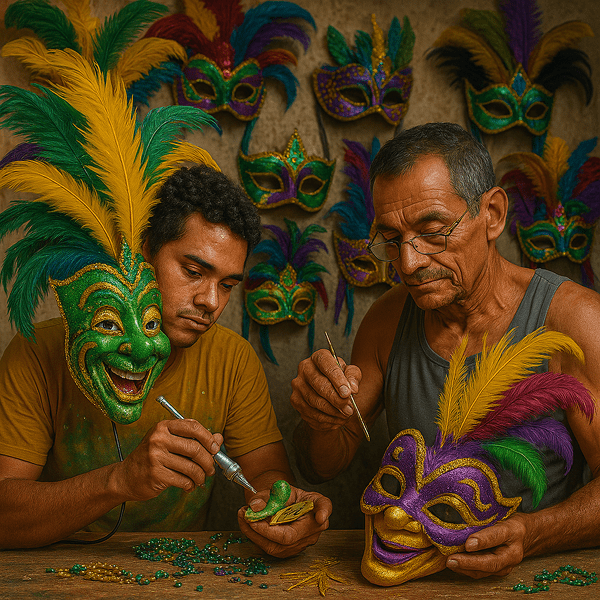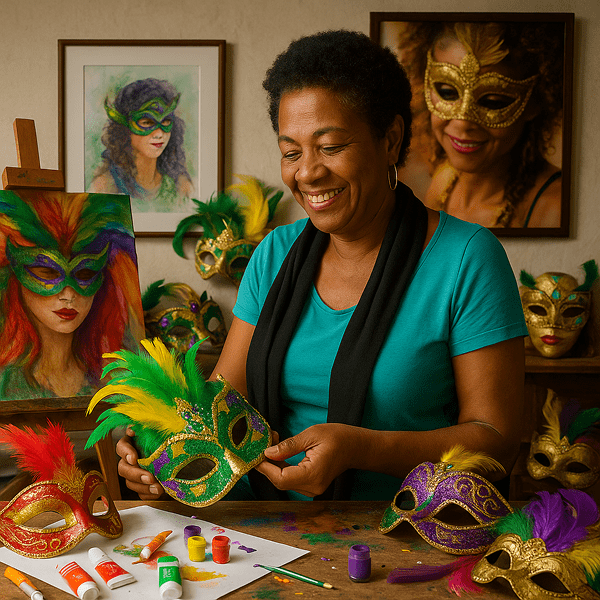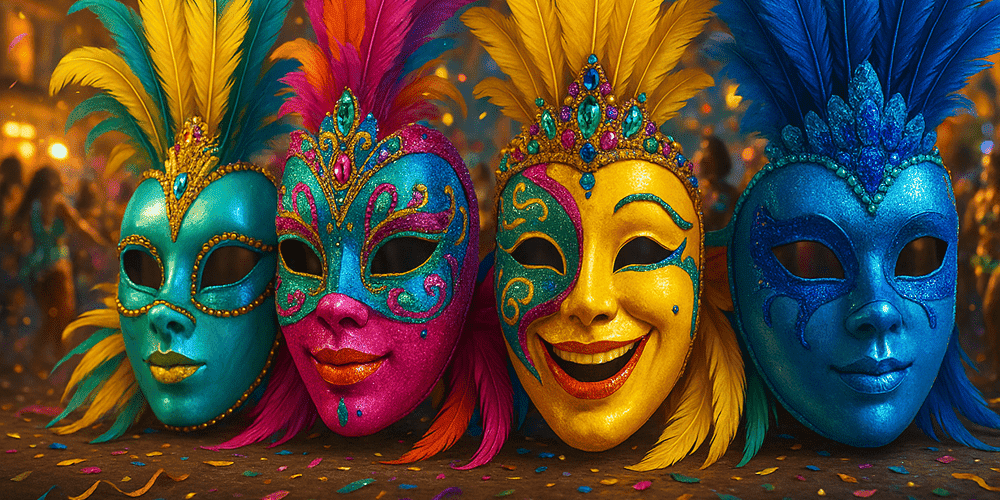Rio de Janeiro Carnival Masks are dazzling, colorful, and exuberant expressions of one of the world’s most famous and lavish festivals. These masks are instantly recognizable for their vibrant feathers, sparkling sequins, bold shapes, and intricate decorations. Designed to both conceal and reveal, Rio Carnival Masks help transform participants into mythical beings, characters, animals, and living works of art. Closely associated with the samba parades and street festivities of Rio de Janeiro, these masks have become global symbols of Brazilian culture, creativity, and joy. The tradition emerged in the late 19th and early 20th centuries, blending European masquerade customs with Afro-Brazilian and Indigenous influences unique to Brazil.
Historical Origins of Rio Carnival Masks
The history of Rio de Janeiro Carnival Masks begins with the arrival of Portuguese colonists, who brought the practice of masquerade and carnival from Europe. The word “carnival” comes from the Latin “carne vale,” meaning “farewell to meat,” marking the beginning of Lent. Early Rio Carnival celebrations drew inspiration from Venetian masks and French masquerades, but soon developed their own identity.
By the late 1800s, Rio’s street carnival had exploded in popularity, with masked balls, processions, and samba gatherings. The design and function of the masks evolved alongside the rise of samba schools and the influence of African and Indigenous Brazilian traditions. Over time, Rio Carnival Masks became more elaborate, fantastical, and theatrical, reflecting the city’s diverse heritage and the spirit of innovation. Notable historical moments include the first samba parades in the 1930s and the increasing spectacle of masks in the Sambadrome parades. Surviving masks, photographs, and paintings in museums offer a window into the changing aesthetics of Rio Carnival.
Cultural Significance and Symbolism of Rio Carnival Masks
In Brazilian culture, Rio Carnival Masks are rich in symbolism and meaning. They represent transformation, liberation, and the breaking down of social boundaries. Wearing a mask allows participants to temporarily escape everyday identity, explore fantasy, and celebrate collective joy. In the context of the samba parade, masks often embody archetypes from African-Brazilian religions, such as orixás, spirits, and mythical creatures.
Spiritually, masks connect to the themes of rebirth, transcendence, and the cyclical nature of the seasons. Many Rio Carnival Mask designs carry stories and legends from both African and Indigenous Brazilian mythology. Socially, masks foster unity, equality, and the playful inversion of social hierarchies, encouraging everyone — regardless of status — to join the celebration. The mask thus becomes a tool of both cultural preservation and creative rebellion.
Materials and Crafting Techniques of Rio Carnival Masks
The making of Rio de Janeiro Carnival Masks is an art that combines tradition, innovation, and spectacle. Common materials include lightweight cardboard, papier-mâché, wire, foam, fabric, sequins, rhinestones, beads, glitter, and — most famously — feathers of every hue. Some masks are hand-sculpted and painted, while others are assembled using hot glue, embroidery, and sewing.
Special techniques include layering feathers for volume, intricate beadwork, airbrushing, and the use of metallic foils. Artisans use scissors, knives, glue guns, sewing needles, and paintbrushes to achieve the desired effect. In some neighborhoods, mask-making is a communal activity, with families or samba school members working together. Regional differences exist: masks for the Sambadrome parades tend to be larger and more elaborate, while street party masks (blocos) are often playful and humorous. Color symbolism is vital — gold for wealth, green for hope, purple for mystery, and red for passion. Decorative elements reflect the themes of each year’s parade or samba school.
Discover in-depth crafting guides and interviews with Brazilian mask-makers on toddmasks.com.

Functions and Uses of Rio Carnival Masks
Rio Carnival Masks serve a variety of festive, theatrical, and ritual purposes. In the samba parades, masks are worn by dancers, drummers, and float riders to complement costumes and enhance the storytelling of each performance. Outside the Sambadrome, masks are central to street parties (blocos), masquerade balls, and children’s events.
Historically, masks played a ceremonial role in pre-Lenten rituals, symbolizing the transition from one season to another. In modern times, their use has expanded to include parties, theatrical productions, fashion shows, and international festivals. Rio Carnival Masks are also used for satire, political commentary, and social critique, echoing the tradition of Mardi Gras Masks in New Orleans.
Regional Variations of Rio Carnival Masks
While Rio de Janeiro is the heart of this mask tradition, regional variations abound across Brazil. In Salvador and Recife, masks reflect Afro-Brazilian religious motifs and often use natural materials. In São Paulo, large-scale parades feature both Rio-style masks and unique local innovations. Amazonian Carnival masks may incorporate Indigenous elements, animal motifs, or natural fibers.
Distinctive local features include the use of specific color palettes, shapes, and themes. In the south of Brazil, Italian and German immigrant communities have their own masquerade traditions, sometimes blending with samba styles. Comparing Rio Carnival Masks to masks from other cultures, such as Venetian Carnival Masks or Caribbean Carnival Masks, reveals both shared roots and distinct Brazilian creativity.
Famous Examples and Collections of Rio Carnival Masks
Some of the most famous Rio Carnival Masks are preserved in museums, samba school archives, and private collections. The Museu do Carnaval in Rio de Janeiro showcases historic masks, costumes, and parade memorabilia. The Samba Museum and the Museu de Arte Popular also feature rare and significant examples.
Private collectors often display masks worn by legendary samba dancers, parade queens, or renowned designers. Photographic archives, television footage, and temporary exhibitions capture the evolution of mask styles over time. toddmasks.com offers curated digital galleries and expert commentary on important and beautiful Rio Carnival Masks.
Influence of Rio Carnival Masks on Art and Culture
Rio de Janeiro Carnival Masks have had a profound influence on Brazilian and global art, fashion, music, and performance. Their vibrant forms inspire painters, costume designers, and set decorators worldwide. In literature, masks appear in Brazilian poetry, novels, and memoirs, symbolizing both joy and hidden identity. In film and television, the Rio Carnival Mask is a universal symbol of celebration and spectacle.
Samba music, with its elaborate rhythms and lyrics, often references masks and masquerade. Contemporary fashion designers in Brazil and abroad use Rio Carnival Mask motifs in haute couture and streetwear. The preservation of mask traditions is vital for maintaining Brazil’s cultural heritage and fostering continuous artistic innovation.

Contemporary Status and Preservation of Rio Carnival Mask Tradition
Today, the tradition of Rio Carnival Masks is alive and thriving. Master artisans, samba schools, and community workshops continue to produce masks using both traditional and innovative techniques. Mask-making classes, festivals, and museum programs introduce new generations to the craft. Eco-friendly materials, digital design, and collaborations with international artists mark modern adaptations.
Preservation efforts include museum exhibitions, oral history projects, and cultural education in schools. Samba schools play a central role in maintaining and evolving mask traditions, ensuring that each year’s Carnival brings new themes and designs. toddmasks.com supports this heritage by offering resources, interviews, and masterclasses for enthusiasts and makers.
Collecting and Acquiring Rio Carnival Masks
The market for Rio Carnival Masks is vibrant, with options ranging from affordable souvenirs to rare, artist-signed collector’s pieces. Authentic masks are available from artisan studios, samba school boutiques, museum shops, and reputable online platforms such as toddmasks.com. Prices depend on materials, craftsmanship, provenance, and decorative complexity.
Collectors should seek hallmarks of authenticity, such as signature techniques, high-quality materials, and documentation of use in major parades. Mass-produced or imported plastic masks are less valuable. Ethical collecting supports local artisans, respects cultural origins, and avoids counterfeit or culturally sensitive items. Toddmasks.com provides expert advice on authenticity, valuation, and responsible collecting.
